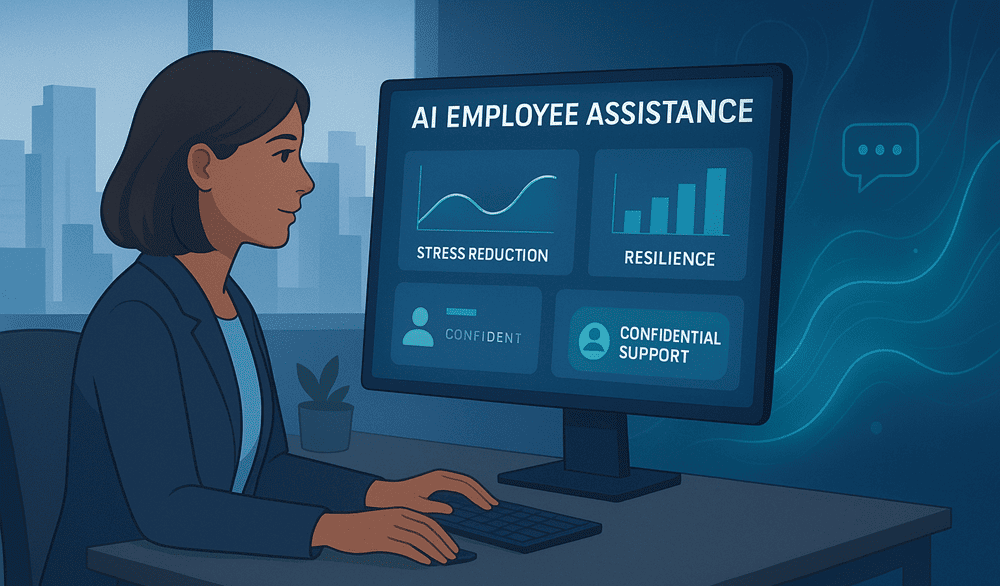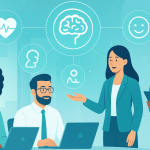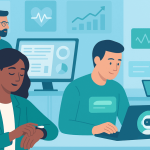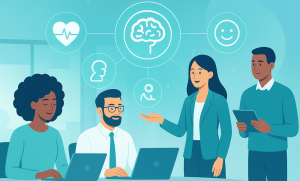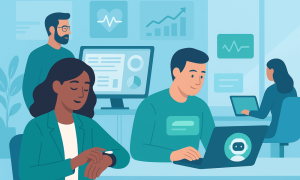Employee wellbeing is no longer a side initiative—it’s a critical component of organizational success. For decades, Employee Assistance Programs (EAPs) have provided workers with access to counseling, stress management resources, and support services. But traditional EAPs often face barriers: low utilization, limited personalization, and reactive rather than proactive support.
That’s changing with the rise of AI employee assistance solutions. By combining data-driven insights with real-time coaching, AI is reshaping EAPs into next-generation wellbeing systems that are more accessible, personalized, and effective than ever before.
Why Traditional EAPs Struggle
Despite good intentions, traditional employee assistance programs often fall short:
- Low awareness and engagement: Many employees don’t even know their EAP exists.
- Stigma: Workers hesitate to use counseling services for fear of being judged.
- One-size-fits-all: Programs often lack customization for individual needs.
- Reactive, not proactive: Support typically kicks in only once problems escalate.
As a result, utilization rates for EAPs often sit below 10%, meaning organizations invest heavily but see minimal impact. Enter AI-powered assistance—the game changer that is modernizing how support is delivered.
What Is AI Employee Assistance?
At its core, AI employee assistance uses artificial intelligence to enhance traditional EAP offerings with real-time, personalized, and scalable support. It integrates with existing HR systems and wellness programs to offer employees guidance anytime, anywhere.
Key features include:
- 24/7 availability: AI chatbots and digital wellness coaches provide support around the clock.
- Personalized interventions: Tools adapt based on an employee’s stress signals, work habits, or feedback.
- Predictive insights: AI can flag potential wellbeing risks before they escalate into burnout or turnover.
- Confidential, stigma-free use: Employees can access private AI coaching without fear of judgment.
How AI is Transforming Next-Gen EAPs
AI technology doesn’t replace human counselors—it enhances them. The next wave of AI employee assistance focuses on creating hybrid models where employees benefit from both automated support and human expertise.
1. Real-Time Stress Monitoring
Through natural language processing and wearable integrations, AI tools can identify early signs of stress, anxiety, or disengagement. Instead of waiting for an employee to request help, the system offers immediate guidance for stress reduction in the workplace.
2. Personalized Coaching and Resources
Unlike generic wellness tips, AI personal wellbeing tools deliver context-aware nudges. For example, if an employee’s workload spikes, the system might suggest micro-breaks, resilience exercises, or scheduling adjustments.
3. Scalable Emotional Support
Human counselors are invaluable but limited in capacity. AI allows organizations to scale support to thousands of employees simultaneously while still offering referrals to professionals for deeper concerns.
4. Enhanced Data for HR Leaders
AI-powered EAP dashboards provide anonymized insights into workforce wellbeing trends. HR leaders can see patterns around stress, burnout risk, or engagement dips and act proactively.
Benefits of AI-Powered EAPs
Shifting from traditional programs to AI employee assistance brings several advantages:
- Higher utilization rates due to ease of access and reduced stigma.
- Improved employee resilience with proactive support during peak pressure times.
- Better retention and productivity, as employees feel supported and valued.
- Stronger mental health outcomes, thanks to continuous, data-driven care.
For companies, the return on investment comes not only in cost savings but in building a healthier, more engaged workforce.
Examples of AI in Action
Next-gen EAPs are already being adopted across industries. Some real-world applications include:
- Digital wellness coach integrations that provide mindfulness sessions, resilience training, and mood tracking.
- AI-powered chat assistants offering confidential advice and directing employees to relevant EAP resources.
- Predictive analytics dashboards that flag teams at risk of burnout, enabling HR leaders to intervene early.
- Voice-based wellbeing tools that analyze tone and language in calls or meetings to identify rising stress levels.
These innovations create a workplace environment where wellbeing is not just an afterthought but an embedded part of company culture.
AI and Employee Privacy
One of the most important considerations in AI employee assistance is privacy. Employees must feel confident that their personal data won’t be misused. Leading platforms ensure:
- Anonymized reporting (no individual-level data shared with employers).
- Consent-driven usage, allowing employees to opt in.
- Strong data security protocols to protect sensitive information.
Transparency builds trust, making employees more likely to engage with these digital solutions.
The Future of AI in Employee Assistance
Looking ahead, next-gen EAPs powered by AI will likely feature:
- Seamless integration with daily workflow tools like Slack, Teams, and calendars.
- Multilingual AI coaches, ensuring global accessibility.
- More human-like interactions, with AI capable of emotional understanding and empathetic responses.
- Predictive workforce wellbeing analytics, helping organizations anticipate large-scale burnout risks.
This future isn’t far away—it’s unfolding now as companies search for ways to balance performance with wellbeing in increasingly demanding work environments.
Why Leaders Should Pay Attention
Investing in AI employee assistance is not just about keeping up with technology—it’s about addressing a growing business imperative. Mental health challenges cost organizations billions annually in lost productivity, absenteeism, and turnover.
By modernizing EAPs with AI, leaders can:
- Create workplaces that foster resilience and sustainability.
- Demonstrate genuine care for employee wellbeing.
- Build a competitive advantage by attracting and retaining top talent.
This shift aligns with broader initiatives like AI for mental wellbeing, workplace mindfulness, and AI resilience coaching, showing that technology can humanize, rather than depersonalize, the employee experience.
Final Thoughts
The next generation of Employee Assistance Programs is here—and it’s powered by AI. Traditional EAPs will continue to play an important role, but AI employee assistance ensures that support is proactive, scalable, and personalized for every worker.
For employees, it means having a confidential, always-available coach to lean on. For organizations, it means building healthier, more resilient teams capable of thriving in high-pressure environments.
In short, AI isn’t replacing the human touch in EAPs—it’s making it more accessible and effective than ever before.

